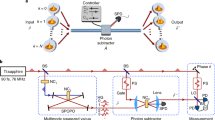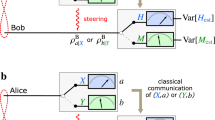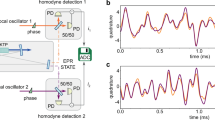Abstract
The distinctive non-classical features of quantum physics were first discussed in the seminal paper1 by A. Einstein, B. Podolsky and N. Rosen (EPR) in 1935. In his immediate response2, E. Schrödinger introduced the notion of entanglement, now seen as the essential resource in quantum information3,4,5 as well as in quantum metrology6,7,8. Furthermore, he showed that at the core of the EPR argument is a phenomenon that he called steering. In contrast to entanglement and violations of Bell's inequalities, steering implies a direction between the parties involved. Recent theoretical works have precisely defined this property, but the question arose as to whether there are bipartite states showing steering only in one direction9,10. Here, we present an experimental realization of two entangled Gaussian modes of light that in fact shows the steering effect in one direction but not in the other. The generated one-way steering gives a new insight into quantum physics and may open a new field of applications in quantum information.
This is a preview of subscription content, access via your institution
Access options
Subscribe to this journal
Receive 12 print issues and online access
$209.00 per year
only $17.42 per issue
Buy this article
- Purchase on Springer Link
- Instant access to full article PDF
Prices may be subject to local taxes which are calculated during checkout




Similar content being viewed by others
References
Einstein, A., Podolsky, B. & Rosen, N. Can quantum-mechanical description of physical reality be considered complete? Phys. Rev. 47, 777–780 (1935).
Schrödinger, E. Discussion of probability relations between separated systems. Proc. Camb. Phil. Soc. 31, 555–563 (1935).
Ekert, A. K. Quantum cryptography based on Bell's theorem. Phys. Rev. Lett. 67, 661–663 (1991).
Jennewein, T., Simon, C., Weihs, G., Weinfurter, H. & Zeilinger, A. Quantum cryptography with entangled photons. Phys. Rev. Lett. 84, 4729–4732 (2000).
Braunstein, S. L. & van Loock, P. Quantum information with continuous variables. Rev. Mod. Phys. 77, 513–577 (2005).
Afek, I., Ambar, O. & Silberberg, Y. High-NOON states by mixing quantum and classical light. Science 328, 879–881 (2010).
Schnabel, R., Mavalvala, N., McClelland, D. E. & Lam, P. K. Quantum metrology for gravitational wave astronomy. Nature Commun. 121 (2010).
The LIGO Scientific Collaboration. A gravitational wave observatory operating beyond the quantum shot-noise limit. Nature Phys. 7, 962–965 (2011).
Wiseman, H. M., Jones, S. J. & Doherty, A. C. Steering, entanglement, nonlocality, and the Einstein–Podolsky–Rosen paradox. Phys. Rev. Lett. 98, 140402 (2007).
Cavalcanti, E. G., Jones, S. J., Wiseman, H. M. & Reid, M. D. Experimental criteria for steering and the Einstein–Podolsky–Rosen paradox. Phys. Rev. A 80, 032112 (2009).
Ou, Z. Y., Pereira, S. F., Kimble, H. J. & Peng, K. C. Realization of the Einstein–Podolsky–Rosen paradox for continuous variables. Phys. Rev. Lett. 68, 3663–3666 (1992).
Reid, M. D. et al. Colloquium: the Einstein–Podolsky–Rosen paradox: from concepts to applications. Rev. Mod. Phys. 81, 1727–1751 (2009).
Saunders, D. J., Jones, S. J., Wiseman, H. M. & Pryde, G. J. Experimental EPR-steering using Bell-local states. Nature Phys. 6, 845–849 (2010).
Wittmann, B. et al. Loophole-free Einstein–Podolsky–Rosen experiment via quantum steering. New J. Phys. 14, 053030 (2012).
Smith, D. H. et al. Conclusive quantum steering with superconducting transition-edge sensors. Nature Commun. 3, 625 (2012).
Werner, R. F. Quantum states with Einstein–Podolsky–Rosen correlations admitting a hidden-variable model. Phys. Rev. A 40, 4277–4281 (1989).
Wagner, K. et al. Entangling the spatial properties of laser beams. Science 321, 541–543 (2008).
Midgley, S. L. W., Ferris, A. J. & Olsen, M. K. Asymmetric Gaussian steering: when Alice and Bob disagree. Phys. Rev. A 81, 022101 (2010).
Reid, M. D. Demonstration of the Einstein–Podolsky–Rosen paradox using nondegenerate parametric amplification. Phys. Rev. A 40, 913–923 (1989).
Eberle, T. et al. Gaussian entanglement for quantum key distribution from a single-mode squeezing source. Preprint at http://arXiv.org/abs.1110.3977 (2011).
DiGuglielmo, J. et al. Experimental unconditional preparation and detection of a continuous bound entangled state of light. Phys. Rev. Lett. 107, 240503 (2011).
Eberle, T. et al. Strong Einstein–Podolsky–Rosen entanglement from a single squeezed light source. Phys. Rev. A 83, 052329 (2011).
Acknowledgements
The authors thank J. Duhme for helpful discussions. This research was supported by EU FP 7 project QESSENCE (grant agreement no. 248095). V.H., T.E., S.S. and A.S. acknowledge support from the IMPRS on Gravitational Wave Astronomy. T.F. and R.F.W. acknowledge support from EU FP 7 project COQUIT (grant agreement no. 233747) and BMBF project QuoRep.
Author information
Authors and Affiliations
Contributions
V.H., T.E. and R.S. conceived the experiment. V.H. and T.E. conducted the experiment and performed all measurements with the help of S.S. and A.S. and under the supervision of R.S. Theoretical analysis was carried out by T.F. with supervision from R.F.W.
Corresponding author
Ethics declarations
Competing interests
The authors declare no competing financial interests.
Rights and permissions
About this article
Cite this article
Händchen, V., Eberle, T., Steinlechner, S. et al. Observation of one-way Einstein–Podolsky–Rosen steering. Nature Photon 6, 596–599 (2012). https://doi.org/10.1038/nphoton.2012.202
Received:
Accepted:
Published:
Issue Date:
DOI: https://doi.org/10.1038/nphoton.2012.202
This article is cited by
-
Quantum correlation in a nano-electro-optomechanical system enhanced by an optical parametric amplifier and Coulomb-type interaction
Scientific Reports (2023)
-
Dynamics of multipartite quantum steering for different types of decoherence channels
Scientific Reports (2023)
-
Experimental hierarchy of two-qubit quantum correlations without state tomography
Scientific Reports (2023)
-
Optimization of tripartite quantum steering inequalities via machine learning
Quantum Information Processing (2023)
-
Does Hawking effect always degrade fidelity of quantum teleportation in Schwarzschild spacetime?
Journal of High Energy Physics (2023)



